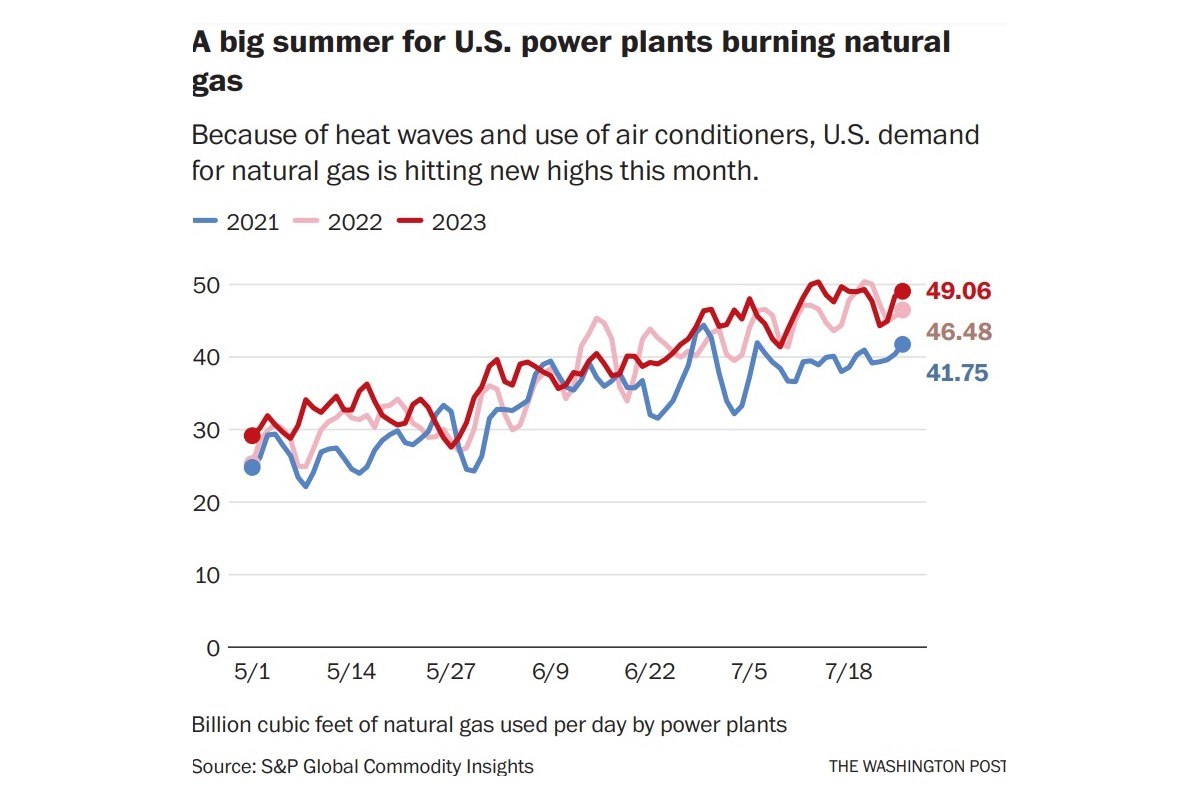
13:23 JST, July 30, 2023
There’s a big winner in the record heat waves baking the United States, China and other countries – fossil fuels.
The United States is setting records for natural gas consumption this week at the power plants that keep the nation’s air conditioners humming, according to estimates from S&P Global Commodity Insights. In China, power plants are burning more coal to keep up with electricity needs, helping to feed a record-pace in demand this year for the world’s largest source of carbon dioxide, the International Energy Agency said Thursday.
That demand is feeding what the Paris energy watchdog calls a “vicious cycle” that further boosts world temperatures. As heat waves multiply and intensify, it creates more demand for fossil fuels, which add to the greenhouse-gas emissions that intensify extreme heat around the world.
The world’s power grids are still too reliant on gas and coal, complicating efforts by the Biden administration and other governments to phase down their use. Despite climate commitments, governments face immediate imperatives to prevent power blackouts and skyrocketing energy prices to cool buildings and protect people from life-threatening conditions.
“The projection for how much energy you need is higher and higher because the cooling needs to go up,” said Jason Bordoff, founding director of the Center on Global Energy Policy at Columbia University. “There are these tragic ironies all over the climate space.”
The problem could grow as the world’s poor add cooling systems. The IEA last week said that only a tenth of the 2.8 billion people who live in the hottest parts of the world already have air conditioning, a huge potential driver for new energy demand and greenhouse gas emissions that are already surging in the developing world.
Last year, nearly a fifth of the global increase in carbon dioxide emissions came from increased energy demand during extreme weather, the IEA said in March. Its report on global carbon dioxide concluded that summer heat waves were the primary reason that the United States and China, the world’s two largest emitters, did not reduce their emissions for the year. In the United States, gas consumption was the culprit, rising to cool buildings as electricity demand peaked, the IEA said.
The World Meteorological Organization declared July to be the hottest month on record, and last year’s trends are reemerging, amplified. The hottest weather of the summer is hitting parts of the United States, with more than 180 million people under heat alerts from the Northeast to the Desert Southwest on Friday.
That widespread swelter led U.S. gas demand at power plants Wednesday to break a record set just a year ago – and then break it again Thursday climbing 3.6 percent in one day to more than 52 billion cubic feet, according to S&P Global Commodity Insights. Its preliminary estimate shows that Friday’s usage is likely to be the second-highest ever.
Since late May in China, heat has helped push a sharp rise in demand for coal-fired power in several of China’s most populated coastal regions, according to data compiled by Goldman Sachs analysts. It comes after a year in which Beijing approved dozens of new coal-burning plants. Meanwhile, Chinese leader Xi Jinping has recently declared that Beijing alone will decide how – and how quickly – to addresses climate change.
The IEA said Thursday that Chinese coal demand grew by more than 5 percent during the first half of the year, feeding global growth. Worldwide coal demand in the first half of 2023 outpaced last year’s record by 1.5 percent. The agency said coal usage is likely to recede through year’s end, but that will depend on the weather.
Several countries outside of the United States and China are mirroring the trend this summer. Power grids in roughly a dozen countries set records for peak demand in the past two months, the IEA said. That includes India, the world’s second-biggest coal consumer, and Japan, which has been burning through gas to address the heat, Goldman analysts said.
“If we don’t speed up how much clean energy we’re building, this will continue to happen and will get worse in the future,” said Robbie Orvis, senior director of energy policy design at Energy Innovation, a nonpartisan think tank. “Fossil fuels aren’t the way out.”
In the United States, dependence on natural gas has become central to policy debates over climate change and energy. Conservatives and some centrists favor gas because the United States has plentiful reserves and it burns with about half the emissions than the coal it often replaces. But more-aggressive climate activists warn that the country is nearing the limit to the benefits that system can produce and that it needs to stop long-term investments in gas that could start preventing the country from reducing emissions further.
The country’s reliance on gas has unfolded over the past 15 years or so. Once a fuel primarily for home heating, its use expanded rapidly as new technology – fracking – slashed the costs of domestic production, and state and federal regulators cracked down on toxic emissions from coal plants.
As a result, U.S. annual gas consumption rose nearly 50 percent from 2006 through last year, repeatedly setting production and consumption records, according to data from the U.S. Energy Information Administration. Over roughly that same period, the country’s greenhouse gas emissions have fallen more than 14 percent, according to Environmental Protection Agency data.
Partly because of such trends, some researchers assert that – in the United States, at least – extreme heat is only a short-term conundrum, addressed with ongoing development of zero-emissions wind and solar power worldwide. Andrew Dessler, a scientist at Texas A&M University who has studied these dynamics in Texas, said renewables are helping and that factors like population growth and affluence are bigger drivers of emissions than natural gas.
“It’s not a huge impact,” he said. “Yes, it’s pushing us in the wrong direction, but other factors are increasing demand a lot more.”
The country has also made vast strides in adding emissions-free energy, such as wind and solar. And further investment through last year’s giant climate-spending legislation, called the Inflation Reduction Act, is widely expected to accelerate that development and ultimately lower consumption of natural gas. But there is widespread disagreement over when that could happen, with some expecting years of strong gas demand first.
“The system doesn’t change that fast. No big system changes that fast,” said Christi Tezak, managing director at ClearView Energy Partners, an independent research firm. “I have no doubt in my mind we are going to be using gas for quite some time. And almost certainly longer than most environmental groups expect.”
In the meantime, U.S. gas and coal demand – and emissions – are becoming even more strongly tied to the weather. Grid operators tend to use renewable power first, whenever they are available, because wind and sunshine are free. As demand rises, they call upon more gas- and coal-fired plants.
“Almost anywhere in the United States, any incremental increase in electricity demand is met with a fossil resource,” said Glenn McGrath, who leads the electricity supply team at the EIA.
The past two years illustrate this spike. As of Friday, all of the 22 top days when U.S. power plants had their highest consumption of natural gas came last summer and this month, according to S&P.
Parts of the South, the hottest parts of the country, use six times as much energy to cool commercial buildings as the coolest parts of the country, according to data the EIA put out Thursday. Because the heat is so intense, those regions are not just cooling more buildings more often, but also cooling more of the floor space of every building to cope, creating more intense demand at higher temperatures.
Many environmental groups argue that this intense demand shows the urgent need to phase out fossil fuels. But some groups have concluded that these trends show that it is impossible to eliminate fossil fuels quickly enough to address climate change. They advocate for attaching systems that capture carbon dioxide to existing fossil-fuel-burning plants as a way to reduce emissions.
The Biden administration has proposed requirements that could lead many gas- and coal-burning power plants, starting in the 2030s, to install carbon capture. The Clean Air Task Force, an environmental organization, says the country must mandate those changes alongside a more rapid build-out of renewable power – in part because of how extreme weather affects the energy system.
“The extremes absolutely make the challenges harder,” said Ben Longstreth, who leads carbon-capture advocacy for the group. “We need all of these tools.”
"News Services" POPULAR ARTICLE
-

American Playwright Jeremy O. Harris Arrested in Japan on Alleged Drug Smuggling
-

Japan’s Nikkei Stock Average as JGB Yields, Yen Rise on Rate-Hike Bets
-

Japan’s Nikkei Stock Average Licks Wounds after Selloff Sparked by BOJ Hike Bets (UPDATE 1)
-

Japan’s Nikkei Stock Average Buoyed by Stable Yen; SoftBank’s Slide Caps Gains (UPDATE 1)
-

Japanese Bond Yields Zoom, Stocks Slide as Rate Hike Looms
JN ACCESS RANKING
-

Tokyo Economic Security Forum to Hold Inaugural Meeting Amid Tense Global Environment
-

Keidanren Chairman Yoshinobu Tsutsui Visits Kashiwazaki-Kariwa Nuclear Power Plant; Inspects New Emergency Safety System
-

Imports of Rare Earths from China Facing Delays, May Be Caused by Deterioration of Japan-China Relations
-

University of Tokyo Professor Discusses Japanese Economic Security in Interview Ahead of Forum
-

Japan Pulls out of Vietnam Nuclear Project, Complicating Hanoi’s Power Plans
























